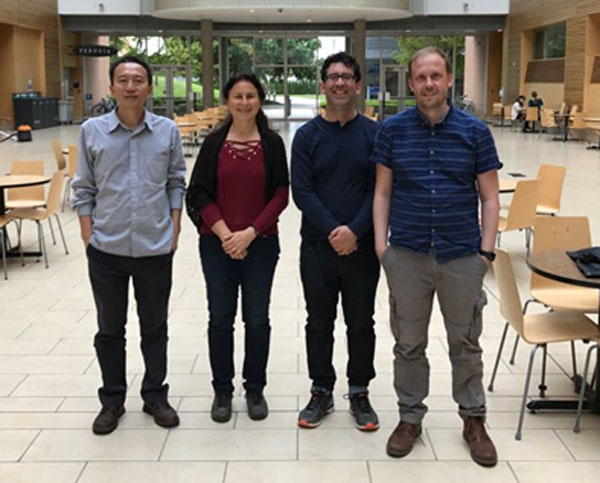Most cells in the human body are held in place via attachments to a dense meshwork of proteins called the extracellular matrix. The adhesions to the matrix serve as sophisticated mechano-sensory structures, able to sense the physicality of the surroundings and convert these physical signals into biological signals. Understanding the remarkable versatility of the signalling outputs of these complexes as they respond to subtle changes in forces was the aim of the team’s HFSP project.

From left: Jie Yan, Anna Akhmanova, Guy Tanentzapf and Ben Goult during their HFSP team meeting in Vancouver, Canada in May 2017
To achieve this goal, the team studied how the core component in these complexes, the protein talin, responds to changes in force. They looked at this protein at the single molecule level (Yan lab), the structural and biochemical level (Goult lab) in cells using super resolution microscopy techniques (Akhmanova lab) and in the fruit fly, Drosophila (Tanentzapf lab). By studying how these proteins work on different scales, the team were able to define in detail how these mechanical linkages form and send signals into the cell.
The team discovered that talin is a complex mechanosensor with 13 force-dependent binary switches in each molecule. These switches turn “on” and “off” different cellular functions depending on whether they are in the folded “0” or the unfolded “1” state. By changing its shape as a function of force, talin is able to orchestrate multiple cytoskeletal systems in the cell to influence cell shape, dynamics and signalling outputs. In 2016, the team reported that one of the talin switches, through its interaction with KANK proteins, regulates the connection of adhesions to microtubules (Bouchet et al., 2016). Then in 2019, the team made a technological advance enabling the measurement of how forces alter the talin-KANK interactions, which showed that forces dramatically alter how these proteins interact (Yu et al., 2019).
In 2021, towards the culmination of their HFSP project, the team published three papers that together provide a novel view of the way that talin orchestrates the mechanical linkages and mechanosensing in cells. Firstly, a study published in the Journal of Biological Chemistry reports that during the cell cycle the switches in talin are altered by the enzyme cyclin dependent kinase 1 (CDK1), which has the striking effect of altering the order in which the switches unfold. This leads to the notion that the mechanical coding of the cell might be altered as a cell divides (Gough et al., 2021). Secondly, the team shows that opening the switches to the “1” state has a dramatic effect on the activity of other molecules, and a study published in the Journal of the American Chemical Society showed that force on talin flicking these switches was sufficient to activate another protein, vinculin (Wang et al., 2021). These binary switches can initiate large alterations in the protein complexes that form at these adhesion sites. Thirdly, having identified these important mechanical binary switches, the team looked for other proteins that contain them and identified a novel member of the talin family of proteins, an essential gene called Talin Rod Domain Protein 1 (TLNRD1) and showed that TLNRD1 coordinates cell adhesion and migration (Cowell et al., 2021).
As the Program Grant draws to a close, the team reflects on the successes of this grant, with over 20 publications resulting from the collaboration. The landscape for how cells sense mechanical forces has been transformed by the notion of this mechanical coding that cells are using to control their biological processes. With several papers in preparation based on the collaborations facilitated by the grant, the team will hopefully continue to work together in the future to build on the discoveries of the HFSP funded research.
|
References Bouchet, B.P., R.E. Gough, Y.C. Ammon, D. van de Willige, H. Post, G. Jacquemet, M.A. F., A.J.R. Heck, B.T. Goult, and A. Akhmanova. 2016. Talin-KANK1 interaction controls the recruitment of cortical microtubule stabilizing complexes to focal adhesions. Elife. 5:e18124. doi:10.7554/eLife.18124. Cowell, A.R., G. Jacquemet, A.K. Singh, L. Varela, A.S. Nylund, Y.-C. Ammon, D.G. Brown, A. Akhmanova, J. Ivaska, and B.T. Goult. 2021. Talin rod domain–containing protein 1 (TLNRD1) is a novel actin-bundling protein which promotes filopodia formation. J. Cell Biol. 220. doi:10.1083/JCB.202005214. Gough, R.E., M.C. Jones, T. Zacharchenko, S. Le, M. Yu, G. Jacquemet, S.P. Muench, J. Yan, J.D. Humphries, C. Jørgensen, M.J. Humphries, and B.T. Goult. 2021. Talin mechanosensitivity is modulated by a direct interaction with cyclin-dependent kinase-1. J. Biol. Chem. 297:100837. doi:10.1016/j.jbc.2021.100837. Wang, Y., M. Yao, K.B. Baker, R.E. Gough, S. Le, B.T. Goult, and J. Yan. 2021. Force-dependent interactions between talin and full-length vinculin. JACS. (in press). doi:10.1101/2021.04.26.441533. Yu, M., S. Le, Y.C. Ammon, B.T. Goult, A. Akhmanova, and J. Yan. 2019. Force-Dependent Regulation of Talin-KANK1 Complex at Focal Adhesions. Nano Lett. 19:5982–5990. doi:10.1021/acs.nanolett.9b01732. |
|
HFSP award information Research Grant - Program (RGP0001/2016): Control of cell migration and polarity by a mechanosensory complex linking adhesion and microtubules Principal investigator: Anna Akhmanova, Utrecht University, Netherlands (nationality: Russia/Netherlands) |


































